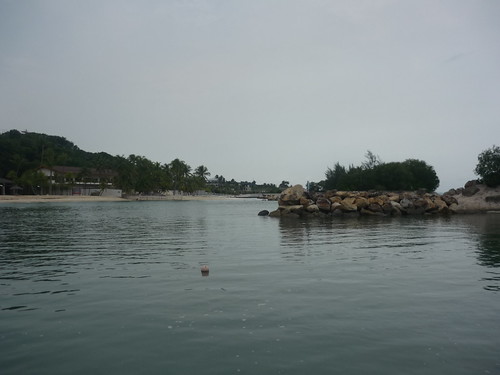
Today's a free day, so I decided to head down to catch some sunshine on Siloso Beach. The weather didn't look too good though.
There are several small artificial islets just off the beach. One of them is connected to Sentosa by a floating bridge.
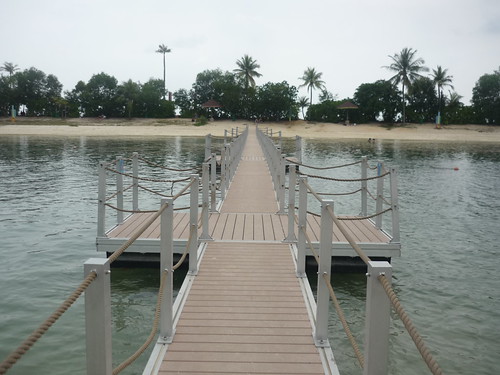
One day, I'll have to explore these islets at low tide. Previous cursory visits during my suntanning sessions have revealed quite a lot of marine diversity; among the many creatures I've found have included a wide variety of fish, snails, crabs, and even a common sea star (Archaster typicus). Not to mention that hair-raising encounter with a small estuarine stonefish (Synanceia horrida)!
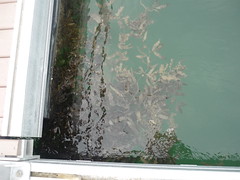
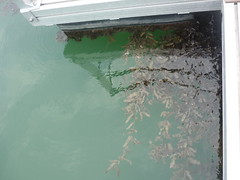
There's plenty of sargassum (Sargassum sp.) growing around the bridge. It looks like this beach is in the midst of an algae bloom.
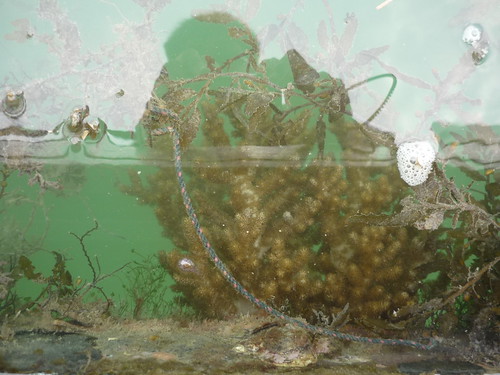
Among the seaweed, I come upon a surprising find: a soft coral!
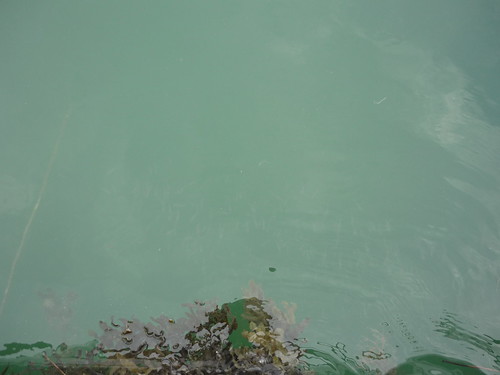
I manage to spot a few shoals of fish swimming.
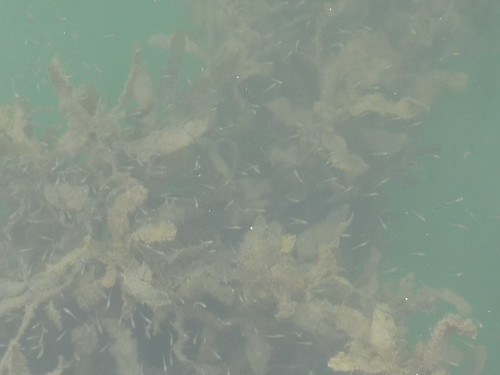
While groups of tiny fish hide amongst the seaweed.

Unfortunately, the bridge also traps a lot of floating debris. What a disgusting filthy mess.
I swim across to one of the small islets across the lagoon, and relax on the beach for a while, soaking up the sunshine. I soon discover why cirolanids are to be feared.
Cirolanids are a family of isopods, and belong to the same group as your more familiar woodlice and sea slaters (Ligia sp.). These tiny critters are most commonly encountered feeding on fish carcasses washed up on our shores. Watching them pour out of a dead fish like so many tiny cockroaches sends shivers down my spine every time I see it happen.

Here's a photo of one that emerged from a dead fish that I found on Changi earlier this month.
I've learned that when there's a dead fish on the beach, it doesn't take long for the cirolanids hiding in the sand to catch a whiff of decaying flesh, and they quickly home in on the source, where they burrow into the carcass and start feasting on it from the inside. Like many other marine creatures, these little scavengers carry out an essential role in consuming carcasses and recycling nutrients.
And as I find out, despite their size, they pack a painful bite.
I'm just lying down on the beach, at the water's edge, when I suddenly feel a sharp pain behind my ear, as if an ant had bitten me. I reach behind, pluck off the offending object, and am startled to see that it's a cirolanid. I quickly fling it away and scramble to my feet, but not before another cirolanid has crawled up my shorts, decided that I taste like dead fish, and taken a tiny bite out of my waist. To think that I had a cirolanid in my shorts still makes me shudder. At least it didn't seek out other places to explore...
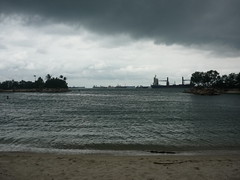
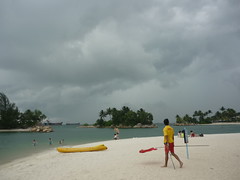

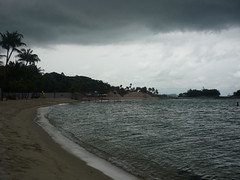
Crossing back to Siloso Beach, I find a nice spot on the beach, one that should be free of cirolanids, and settle down for a nap. But it looks like my afternoon is about to be ruined. I pray that the clouds will pass, and that the sun will reappear, and give me a nice even tan, but to no avail. It soon begins to pour, and I'm forced to abandon my plans and flee for the nearest shelter. Sigh.
Later on, when the rain finally passes, I re-emerge, and try to make the most out of the weak sunshine.
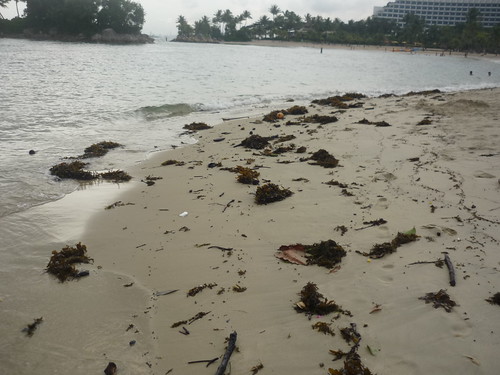
The strong waves have brought even more sargassum washing up on the shore.
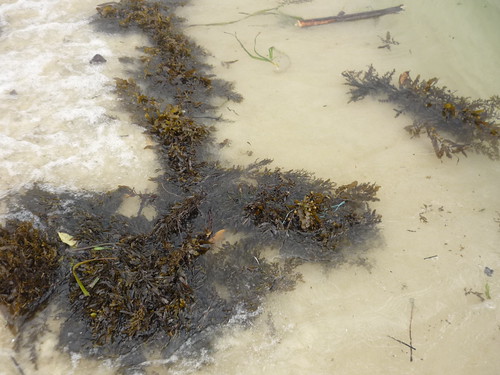
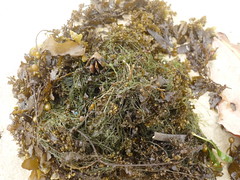

Mixed in with the sargassum are long filaments of green seaweed, possibly Chaetomorpha.
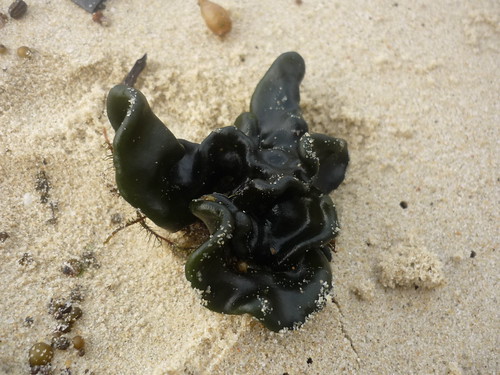
I'm sure this is a kind of algae, I just don't know what it is.
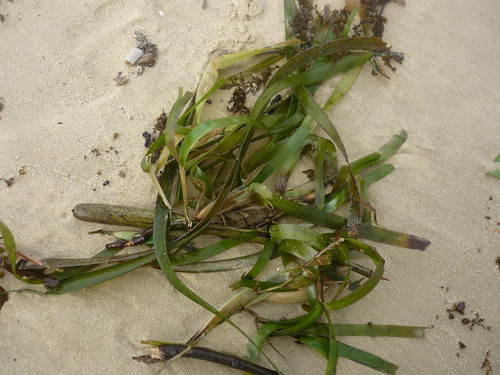
To my surprise, there's also quite a few bits of seagrass among the flotsam. I forgot to check closely and see if these pieces are tape seagrass (Enhalus acoroides). I wonder where all this seagrass is coming from. Did the stormy weather dislodge all this seagrass at nearby Tanjung Rimau or one of our other southern shores, or is there development in the area that's ripping up seagrass beds?
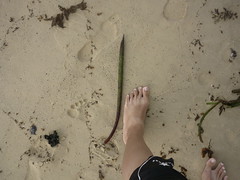

Besides seaweeds and seagrass, I also manage to find a few mangrove seedlings.
While I'm inspecting the sargassum, I get a little surprise. Something is moving inside a clump of seaweed.
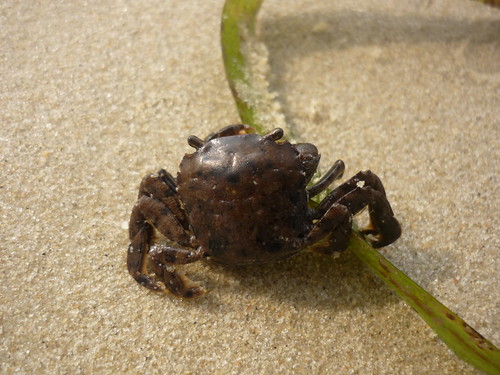
There's a little crab hiding in there!
In all my visits to the shores, I've certainly never seen this species before. It might be a paddler crab (Varuna yui). An entry in A Guide to Seashore Life (where it's listed as Varuna litterata) states that this crab is 'often seen on flotsam or floating seaweed, drifting with the currents'.
After a while, it decides that it's had enough, and scrambles into the sea, where it furiously swims towards the nearest clump of floating sargassum and promptly vanishes.
I finally give up on trying to get a tan. The sun is too weak today, and it looks like I'll have to come back another day if I'm ever going to get any darker.
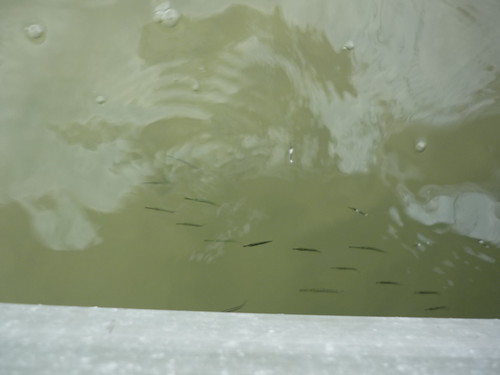
I decide to explore the islet before heading home. While crossing the bridge, I find a shoal of young halfbeaks (F. Hemirhamphidae). It looks like there's more than one species in this school. I also saw a relatively large fish that appeared to be grazing on the sargassum. I didn't manage to take any good photos of it, but I suspect it might be a juvenile rabbitfish (Siganus sp.)
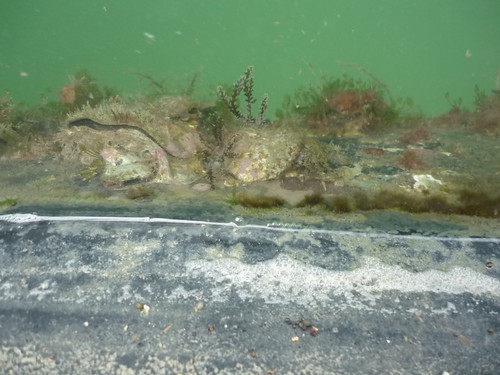
The bridge is really well encrusted with a whole variety of marine life.
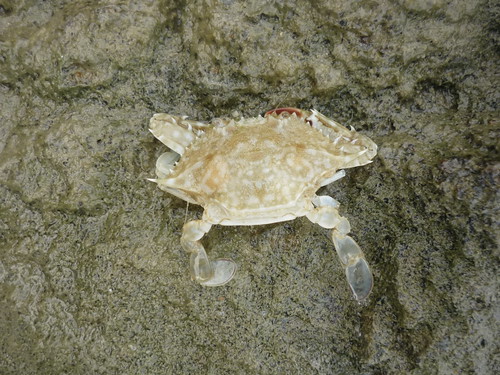
I find the cast-off exoskeleton of a flower crab (Portunus pelagicus).
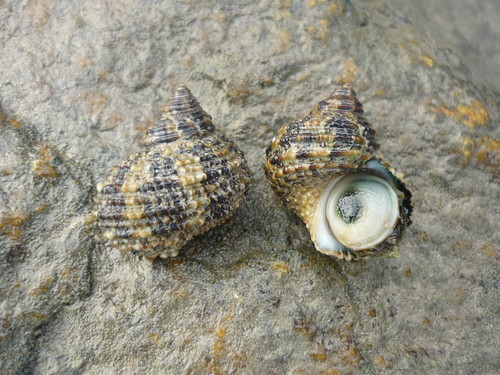
Among the rocks, there are quite a few turban snails (Turbo intercostalis).
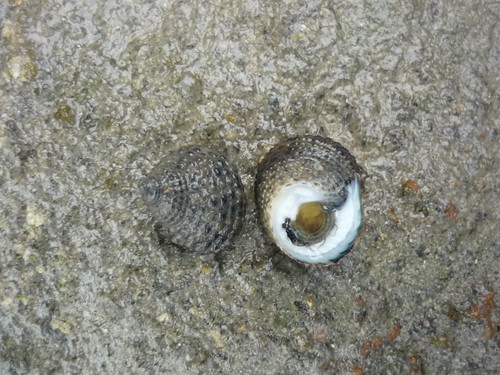
As well as Monodonta labio, a member of the top shell family.
The seabed is also home to various species of creeper snails.
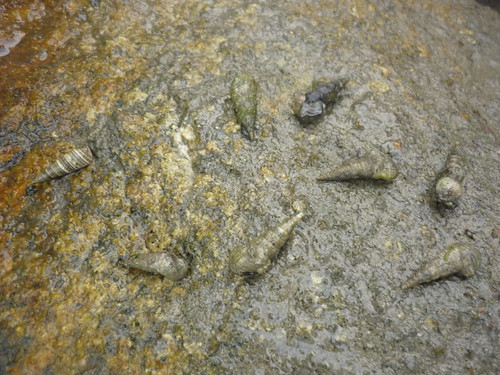
Most common are dense aggregations of Batillaria zonalis.
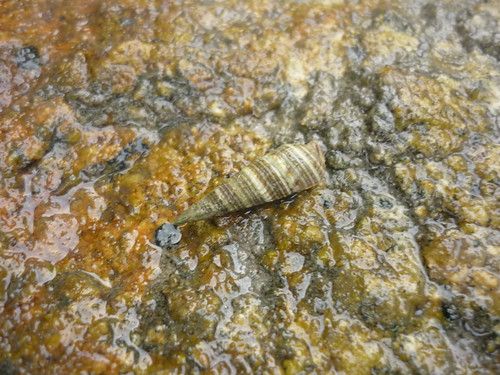
Scattered among them are these snails with bands on their shells. I'm not sure what they are.
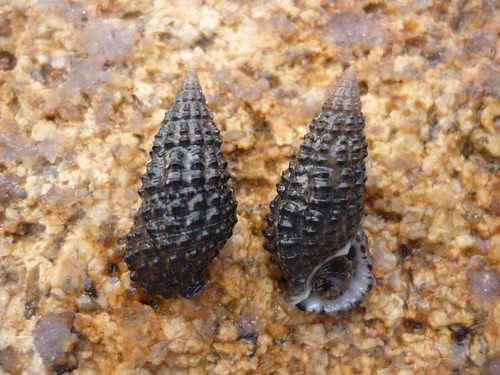
These snails are found individually on the muddy seabed, close to the rocks. They bear a close resemblance to the photo of Cerithium trailli in A Guide to Common Seashells of Singapore.

All these creeper snails support a large population of tidal hermit crabs (Diogenes sp.). There's an idiot-proof way to find hermit crabs among all the snails - if you see a shell on the seabed scuttling away from you, it's definitely a hermit crab.
I also managed to find a small crab.
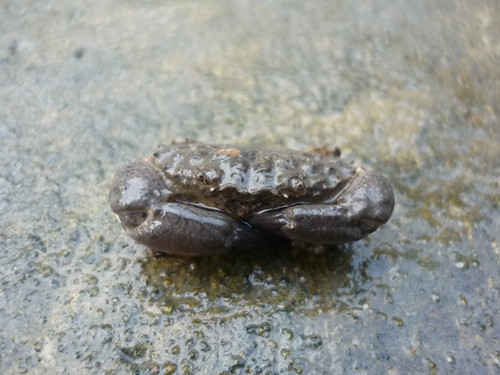
I'm not sure of its exact identity; it could be a common rock crab (Leptodius sp.). The crab responded to my intrusion by playing dead.
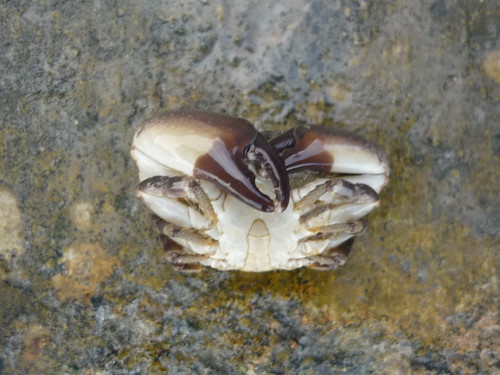
And here's the underside. Damn, I forgot to take a closer look at the pincers. Leptodius has the tips of its pincers shaped like spoons, enabling it to scrape algae from rocks. After taking enough photos, I released it back into the water, where it quickly disappeared beneath a rock.

The best find of the day has to be this tiny squid, only about 2cm long! I wonder if it's a baby squid.
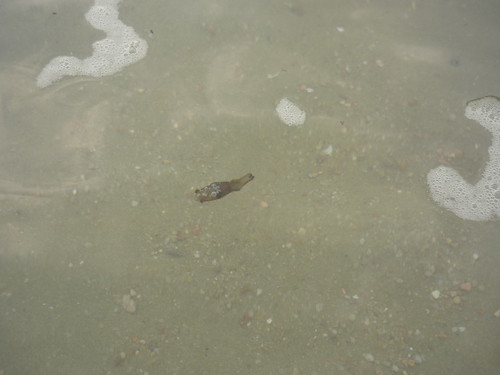
It's extremely alert, and jets away the moment I get too close. While swimming, it's constantly changing colour. It's certainly very easy to miss this little cephalopod; it looks a lot like a little bit of floating rubbish. You have to pay very close attention, and look out for a small object that doesn't quite appear to be drifting with the current all the time.

I finally call it a day, and as I head to the Beach Station, I'm faced with this beautiful evening scene.
I wasn't exactly planning to make this a shore exploration trip, but the thought of looking for marine life was too tempting to ignore, and besides, the lousy weather left me with few other options. I'll be back soon, if only to try and get a proper tan. Maybe I'll try and find my common sea stars...